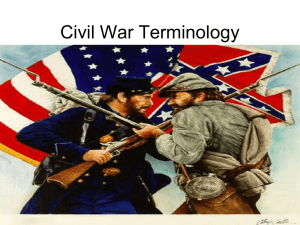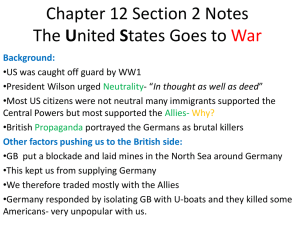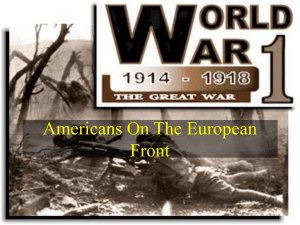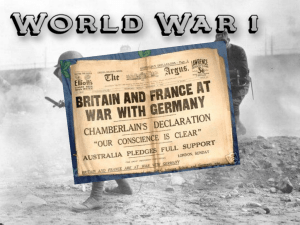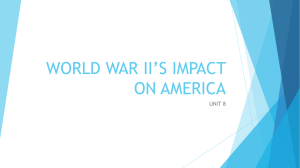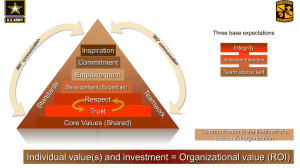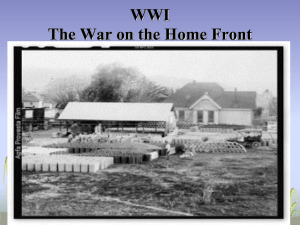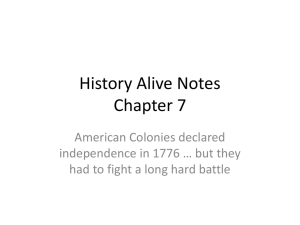Why did the Allies win World War I?
advertisement
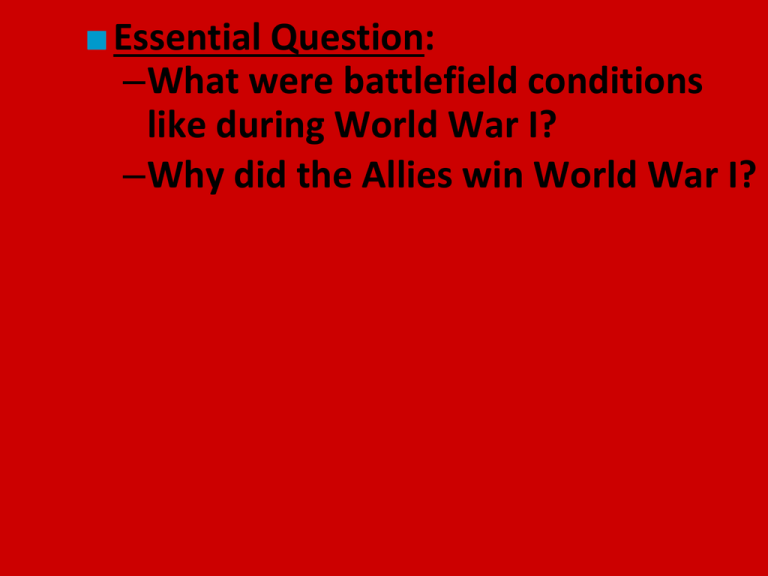
■ Essential Question: –What were battlefield conditions like during World War I? –Why did the Allies win World War I? From 1870 to 1914, the growth of militarism, alliances, imperialism, & nationalism increased tensions increased among European nations Nationalism among Slavs in the Balkans led to the assassination of Archduke Franz Ferdinand in 1914 The conflict between Serbia & Austria-Hungary triggered alliances and started World War I Europe before the Europe at the outbreak of war World War I ■ Text The Allied Powers The Central Powers When the war began in August 1914, Europeans were enthusiastic about fighting French Recruits German Recruits Most people anticipated that the war would be over by Christmas 1914….they were wrong When the war began, Germany’s biggest problem was the potential of fighting on two fronts Germany’s solution was the Schlieffen Plan which involved quickly defeating France in the West… …then sending troops to the East before Russia was fully mobilized for war The Schlieffen Plan seemed to be working when the German army marched through Belgium & France, within miles of Paris But, English & French troops saved Paris at the Battle of the Marne… …Meanwhile, Russia mobilized faster than expected, so Germany had to divert troops from France Because the Schlieffen Plan failed, the Central Powers were forced to fight a two-front war The fighting between Germany & France was known as the Western Front By 1915, the war settled into a stalemate as each side fortified their positions with trenches The fighting between Germany & Russia was known as the Eastern Front Soldiers going “over the top” The soldiers had very little decent food, andTrench what food they Foot had was often attacked by rats. These rats were the size of small rabbits and badgers because they had fed on the decomposing bodies of dead soldiers. New weapons were invented to try to gain an advantage & win the war Machine guns New weapons were invented to try to gain an advantage & win the war Long-range artillery New weapons were invented to try to gain an advantage & win the war Tanks New weapons were invented to try to gain an advantage & win the war Airplanes & zeppelins New weapons were invented to try to gain an advantage & win the war Flamethrowers & grenade launchers New weapons were invented to try to gain an advantage & win the war Poison gas New weapons were invented to try to gain an advantage & win the war Submarines New weapons killed soldiers more effectively; During World War I, 8.5 million soldiers died & 21 million were wounded Fighting on the Western Front slowed to a stalemate as neither side could gain an advantage During the 10 month Battle of Verdun in 1916, 1 million soldiers were killed or wounded Another 1 million soldiers were killed or wounded at the Battle of Somme Despite the deaths, neither the Allies or Central Powers gained an advantage after these battles On the Eastern Front, the Russian army was struggling to hold on against the German military Russian women training for combat Millions of Russian soldiers & civilians died Russia was not as during the war industrialized as the rest of Europe & failed to produce By 1917, Russia was on the brink of collapse enough weapons or food The stalemate on the Western & Eastern Fronts turned World War I into a war of attrition where each side tried to out-produce & outlast the enemy Nations committed to total war to win World War I Factories were converted to make war equipment Industrial resources were rationed in order to prioritize military needs Governments used conscription to draft civilians into the military Propaganda was used to maintain civilian support for the war Overseas colonies were used to gain resources or additional soldiers SikhChinese British Turkish Soldiers Soldiers Cavalry in India To keepGerman Germany u-boat fromattacks tradingplayed with other a rolenations, in Britain bringing used its thenavy USAtointo blockade World War Europe I Germany responded by using unrestricted submarine warfare to attack the British navy & any merchant ships supplying the Allies When World War I began in 1914, the United States remained neutral… …But, the USA was pulled into the war by 1917 As a neutral nation, the USA was trading with the Allies during the war Germany’s policy of unrestricted submarine warfare led to attacks on U.S. merchant ships & British passenger ships President Woodrow Wilson demanded “freedom of the seas” but Germany refused Americans were outraged in May 1915 when a German u-boat sank the British ship Lusitania killing 1,200 people including 128 Americans America’s anger with Germany increased in 1917 after the discovery of the Zimmerman Telegram Germany knew that u-boat attacks would eventually bring the USA into war Germany proposed that Mexico attack the USA in exchange for the return of Texas, New Mexico, Arizona Americans were outraged On April 2, 1917, the United States declared war on Germany & entered the war The arrival of millions of American soldiers in 1918 gave a boost the Allies But in November 1917, Russia signed a peace & exited the war By 1918, the Central Powers But, the Allies were running out of supplies & halted the attack tried a massive attack into France & pushed back Bulgaria, Ottoman Empire, & AustriaHungary surrendered in October 1918 On November 11, 1918 Germany agreed to an armistice (ceasefire) & World War I finally came to an end

